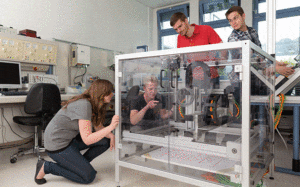As Linked Learning—an innovative high school approach that integrates rigorous academics with real-world experiences—continues to gain momentum among educators and policymakers across the state, SRI Education’s Center for Education Policy has released its fifth annual evaluation report on the progress of the California Linked Learning District Initiative. Whereas previous reports focused on the development and implementation of systems within nine participating districts and provided lessons learned for other interested districts, the fifth-year report focuses on Linked Learning students’ experiences and outcomes.

To offer findings on student engagement and achievement outcomes, we conducted focus groups and surveyed 12th-grade participants who are now about to move on to college, asking questions such as: Who enrolls in pathways? Who stays? How do students feel about their experiences? What are their perceptions of the skills they are gaining? What effect does participation in a Linked Learning pathway have on students’ high school outcomes? We were able to assess pathway students’ experiences with academic curricula and work-based learning, their perceptions of readiness for postsecondary education, and their plans for the future.
Overall, the findings from this year’s report suggest that Linked Learning shows promise for greater student engagement and moderately greater success in school. For example, on average, students enrolled in certified pathways were 5.2 percentage points more likely to remain in their district through 12th grade compared with similar peers in traditional high school programs. In addition, 10th grade students in certified pathways were on average 7.9 percentage points more likely to be on track to complete the suggested a-g requirements—the college prep classes required for California State University (CSU) and University of California (UC) eligibility—than similar peers in traditional high school programs.
Notably, students in certified pathways reported that Linked Learning is helping them develop the 21st century skills needed for college, careers, and life. In particular, they were more likely than students in traditional high school programs to report that high school has helped them develop the following skills.
- Collaboration: Interacting effectively with people from different backgrounds (59% vs. 49%), and in professional settings (54% vs. 33%), and working in a group to achieve a shared goal (56% vs. 36%).
- Communication: Presenting information to an audience, either by public presentation or performing in front of a group (52% vs. 36%), or by speaking in public (43% vs. 27%), and communicating with adults outside of their families (40% vs. 29%).
- Judgment: Using information to make good decisions (55% vs. 38%), conducting online searches to answer a question (52% vs. 36%), summarizing information from multiple sources (45% vs. 32%), and judging whether they can trust the results of an online search (42% vs. 25%).
- Perseverance: Accepting responsibility for the quality of their work (63% vs. 51%), believing they can reach their goals through hard work (55% vs. 45%), and believing they can learn something really difficult if they try (44% vs. 28%).
- Organization: Developing useful self-management skills (35% vs. 27%), developing a system for organizing schoolwork (31% vs. 25%), and managing their time in order to get all their work done (25% vs. 21%).
The findings also suggest that participation in pathways has enhanced students’ understanding of the preparation required for postsecondary opportunities and helped identify career interests. Compared with students in traditional high school programs, students in pathways reported that they received more:
- Opportunities to visit a college or technical school campus (75% vs. 59%) and to speak with a college or trade school representative (74% vs. 65%).
- Help in understanding high school graduation requirements (79% vs. 68%) and the high school courses needed to get into college (64% vs. 51%).
- Help in understanding how to pay for college or training (49% vs. 37%) and what kind of education or training is needed to prepare for a possible career (44% vs. 32%).
This year’s report points to the promise of the Linked Learning approach for California students: There has been significant progress in terms of district leadership and support for Linked Learning. In addition, Linked Learning students are more likely than their peers to be engaged in school, and they experience moderately greater academic success.
Yet there is more work to be done to improve teaching and learning as districts continue to develop and expand Linked Learning. As well, Linked Learning practitioners must work to ensure all kids have opportunities for work-based learning—a key component of pathways—by developing industry partnerships, connecting kids with meaningful opportunities, and bridging those opportunities back to the classroom.
Looking ahead, we will be studying new data on how Linked Learning graduates compare to their peers in the transition to postsecondary—including a-g course completion, graduation rates, and postsecondary enrollment. We’ll also explore how districts can ensure quality of instruction, systems, and supports for Linked Learning pathways while expanding quickly across the state, particularly as they will be transitioning to new sources of funding from the Local Control Funding Formula, the California Career Pathways Trust, and other resources to support Linked Learning.
Since the inception of the Linked Learning initiative in 2009, SRI Education has been studying not only student outcomes, but also how to implement a robust system of Linked Learning pathways, and the significant effort and time it takes to change district systems and structures to support such an endeavor—making this study the most comprehensive, rigorous research on Linked Learning available to date.
College and career readiness is an area of strategic research interest to SRI Education, and our work on Linked Learning has given us deep insight into systemic implementation of major initiatives and associated student outcomes. As Linked Learning expands across the state and across the nation, we are prepared to be part of the conversation about how to study and improve the efficacy of this type of program.


